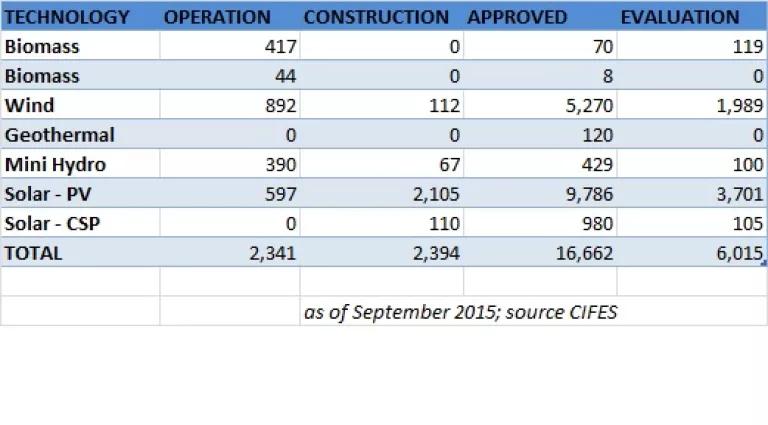
Speaking at the United Nation's General Assembly earlier this week, President Michelle Bachelet announced Chile's contribution to the agreement expected at the Paris climate negotiations this December. Under its Intended Nationally Determined Contribution (INDC), which is available in Spanish here, Chile commits to reducing its emissions intensity by 30 percent by 2030 from the 2007 level. This mitigation target would apply to all sectors of the economy except forestry. Additionally, Chile could increase it emissions intensity reduction target to 35 to 45 percent conditioned on the availability of international funds. Chile also committed to separate targets for the forestry sector aimed at capturing between 1,500,000 tons and 1,800,000 tons of CO2e per year.
Chile's new emission intensity reduction target means the country's emissions in 2030 will be the equivalent of 0.71 tCO2e per million Chilean pesos as compared to 1.02 tCo2e per million pesos in 2007. If Chile meets the high end of its conditional target, its emissions could drop to 0.56 tCO2e per unit of economic output. Under its target for the forestry sector Chile commits to sustainably manage and restore 100,000 hectares of forest, which would represent a reduction of approximately 600,000 tons of CO2e. Chile also commits to reforesting 100,000 acres, representing a further capture and reduction of 900,000 to 120,000 tons of CO2e starting in 2030.
To reach these targets, Chile will work with a series of instruments including: the National Climate Change Action Plan for 2016-2021; the National Sustainable Construction strategy, NAMAs for all sectors of the economy, a CO2 emission tax approved in 2014 and set to be implemented in 2017, a sales tax on light duty vehicles that indirectly targets CO2 emissions; and the National Energy Agenda. According to Energy Minister, Pablo Badenier, Chile is committing to "a scenario of serious and substantiated mitigation" and that "addressing global warming is an urgent task, as is the need to move towards a more sustainable economy."
Yet a coalition of Chilean environmental groups, the Citizen's Committee on Climate Change, is concerned that Chile's INDC is not nearly ambitious enough. They note that mitigation targets do not go far enough toward setting Chile on a low-carbon trajectory and that there isn't enough emphasis on boosting Chile's renewable energy sector. They are also concerned that a significant portion of the proposed reductions are dependent on the passage of a forestry subsidy law that would primarily benefit large-scale plantations, improved economic performance, international support, and that certain commitments in the INDC are actually pre-existing commitments. They affirm that as an OECD country, Chile can do more.
Indeed, Chile's non-conditional emission reduction target is a safe, conservative bet which Chile can meet and certainly exceed. Chile should now focus on laying out the policies and mechanisms that will allow it to achieve the more ambitious, higher end of its conditional target. One key area in this regard is the energy sector* which contributes 75 percent of the country's emissions. Chile's abundant non-conventional renewable energy (NCRE)** resources give it a competitive edge in reducing emissions from energy.

Targeting the right policies to this sector would help Chile achieve important co-benefits from renewable power. A recent study by the New Climate Institute found that getting on a pathway of 100% renewable energy would save Chile $5.3 billion a year on fossil fuels, create 11,000 green jobs and prevent 1,500 premature deaths from outdoor air pollution in Santiago alone.
Chile already has a law that requires that 20 percent of electricity come from non-conventional renewable energy sources by 2025 and the country is well on its way to meet and even exceed this target. Looking back five years ago to 2010, less than 1.5% of the Chile's electricity came from sources like wind and solar. But today, Chile has over 2,300 MW of installed NCRE capacity and these sources contribute 10.17% of Chile's total electricity needs. In fact non-conventional renewables are supplying twice the amount the law established as the minimum threshold for this point in time. What's more, an additional 2,400 MW are under construction and over 20,000 MW are in the pipeline, indicating the incredible potential of the ERNC sector

But for Chile's clean energy sector to really take off, it will be critical for the government to send clear signals of ongoing support for this sector going forward in order to remove remaining barriers.
As President Bachelet noted when she announced Chile's climate pledge "the 2030 Agenda is a shared horizon, now we must act". In line with the urgency that climate change demands, Chile should now focus on concrete actions and policies that will further boost its abundant wind, solar, geothermal and other non conventional renewable resources.
_______
*Includes both electricity generation and transportation
** In Chile non-conventional renewable energy includes wind,s olar, geothermal, mini-hydro, biomass and biogas.
2. Source for emissions per sector: Chile INDC




